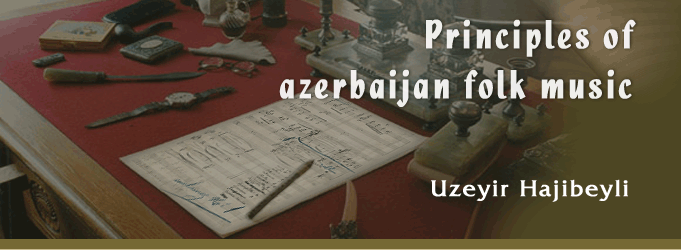

Part two
PRINCIPLES OF COMPOSING MUSIC
IN AZERBAIJANI MODES IN FOLK STYLE
II. THE STRUCTURE OF PERFECT QUINTS3. Composing of Music in the Mode "Chargah"
A. Diapason of the Scale of the Mode "Chargah"
Three equal tetrachords built on the formula 1/2- 11/2 - 1/2 and combined as follows: the lower tetrachord with the medial one - conjointly, and the medial tetrachord with the upper one - separately (mixed combination). It forms the scale of the mode "Chargah".
With the tonic do of the first octave the scale of the mode; "Chargah" is presented in the in the following form:This scale from sol of the minor octave to fa of the first octave forms a successive number of perfect quarts, but from do of the first octave to do of the second octave it forms the number of perfect quints.
In this scale, as in the scale of major gammas, full consequence of the grades is expressed by the gradual succession of perfect octaves.
B. Modal Functions of the Grades and Permissible Steps
In the above scale:
The First grade of the scale has two functions: I) the function of the lower quart of the tonic, 2) the function of the lower leit-tone of the lower third of the tonic. Step from this grade is allowed only to the tonic.
The second grade of the scale functions as the lower third of the tonic. Steps are allowed from this grade to the tonic and to the upper leit-tone of the keynote.
The third grade of the scale has the function of the lower leit-tone of the tonic. Only one step to the upper leit-tone of the keynote (diminished third) is allowed.
The fourth grade of the scale has the function of the tonic of the mode. Steps from this grade are allowed downwards -to the lower third and lower quart, upwards -o to the upper third, the quart and the quint,
The fifth grade of the scale has the function of the upper leit-tone of the keynote. Steps from this grade are allowed: upward- to the upper quart of the tonic, downward- to the lower third of the tonic.
The sixth grade of the scale has the function of the upper third of the tonic. Steps from this grade are allowed: upward- to the quint of the tonic, downward-to the tonic.
The seventh grade of the scale has (he function of the upper quart of the tonic. Steps from this grade are allowed: upwards -to the upper leit-tone of the quint of the keynote, downwards -to the upper leit-tone of the keynote and to the tonic.
The eighth grade of the scale has the function of the quint of the tonic. Steps from this grade are allowed: upwards-to the octave of a the tonic, downwards-to the third of the tonic and to the tonic.
The ninth grade of the scale has the (unction of the upper leit-tone of the quint of (he tonic. I Steps are allowed downwards-to the upper quart of the tonic, upwards-to the octave of the tonic.
The tenth grade of the scale has the function of the lower leit-tone of the octave of the tonic. Only a step (o the quint of the tonic is allowed.
The eleventh grade of the scale has the function of octave of the tonic. Steps from this grade are allowed to the upper leit-tone of the quint and to the quint of the tonic.
C. The Table of Permissible Steps
D. Full and Half CadencesFull cadence ends with the tonic. The tonic of the mode "Chargah" may be approached gradually from above, from below and directly by a step from the lower third, too.
Examples of full cadences:
Half cadences may be expressed by stops in the upper quart and the quint of the tonic. Approaches to the above-shown grades may be gradually from above and below. Examples of half cadences:
Note. With regard to its tonality, as the tonic of the mode "Chargah" has several functions (the function of the main tone, the quart and the third), there are frequent cases when the phrase, while ending in the tonic, produces the impression of half cadence.
[ Chargah: pages 1 2 3]



